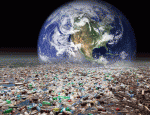United States – A research team at NASA’s Kennedy Space Center in Florida is carefully assessing small tiles made of space trash to explore the potential for storing them safely aboard spacecraft or using them for radiation shielding during a ‘deep-space mission’.
Produced at California’s Ames Research Center, the so-called circular ‘space tiles’ contain plastic water bottles, scraps of clothing, duct tape and foil drink pouches – all remnants from an astronaut’s time spent ‘living in space’. The Ames engineers have built a special compactor to treat the material by melting instead of incinerating it.
This process transforms about ‘a day’s worth of garbage’ into a disc of 20 cm in diameter and just over 1 cm thickness – a reduction of at least 10 times from the original size, according to NASA.
‘One of the ways these discs could be reused is as a radiation shield because there’s a lot of plastic packaging in the trash,’ notes Dr Mary Hummerick, a microbiologist at Kennedy. For example, it is possible that astronauts’ sleeping quarters could be set up as a ”storm shelter’ to keep the crew safe from solar flares.
The compactor heats the trash for over three hours to between 150 and 250 degC so as to kill any micro-organisms. Eliminating bacteria is vital, asserts Dr Hummerick, adding that incorporating the recycled content prematurely might endanger life on another planet. Also, NASA policy dictates avoiding contaminating other worlds.
NASA underlines that handling trash is ‘an important consideration’ for several reasons. ‘First, no-one wants a cramped spacecraft to become overrun with garbage,’ it states. ‘Second, resources will be extremely limited for a crew that will be expected to live in space for up to two years, the time it would take for a Mars mission.’
For more information, visit: www.nasa.gov
Don't hesitate to contact us to share your input and ideas. Subscribe to the magazine or (free) newsletter.



